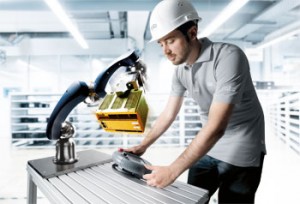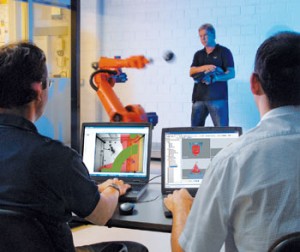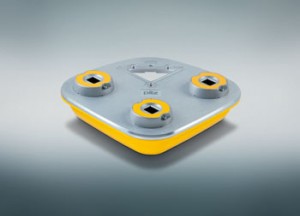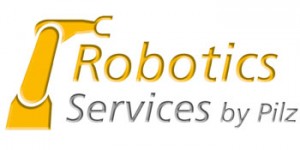Pilz addresses safety for collaborative robots
 As the efficiency of robot applications generally increases, the closer human and machine are able to work together. Static safeguards are increasingly reaching their limits. The trend is moving away from full enclosures for robot cells in favour of human-robot collaborations (HRC), which manage without guards where possible, but still guarantee operator safety. In practice, each application requires a separate safety-related assessment
As the efficiency of robot applications generally increases, the closer human and machine are able to work together. Static safeguards are increasingly reaching their limits. The trend is moving away from full enclosures for robot cells in favour of human-robot collaborations (HRC), which manage without guards where possible, but still guarantee operator safety. In practice, each application requires a separate safety-related assessment
Robots are classed as partly completed machinery in terms of the Machinery Directive. The two standards ISO 10218 “Safety of Industrial Robots” Part 1: “Robots” and Part 2: “Robot systems and integration” are available for detailed safety requirements. Both parts are published as EN ISO 10218-1:2011 and EN ISO 10218-2:2011 and are listed as harmonised C standards under the Machinery Directive 2006/42/EC. Part 2: “Robot systems and integration” also contains information on collaborative operation, and there is an accepted de facto requirement for all safety functions to meet Category 3 / PL d of EN ISO 13849-1.
When planning an HRC application, robot selection is an important element for the systems integrator. Various methods can be applied to verify and validate safety requirements, including visual inspections, practical tests and measurements. The systems integrator has to verify or validate over 200 points in all. The status of the standards is clear, therefore. In practice, however, the question remains as to whether an HRC can be implemented safely with this standards framework. There is some guidance found in HSE’s guidance document HSG43. The Technical Specification ISO/TS 15066: “Robots and Robotic Devices – Collaborative industrial robots” is intended to demonstrate the ways forward and is due for publication by the end of 2015.
Steps toward a safe HRC application
When the normative specifications are implemented, the fact that robot cells are classified as a machine under the Machinery Directive means that each step of the conformity assessment procedure must be completed. It should be noted that the robot itself is only regarded as partly completed machinery; it is not until the end effector or the necessary tool for the respective application is in place that the robot achieves a specific purpose and must then be regarded as final machinery. The integrator or user becomes the manufacturer of the machinery and is responsible for the safety-related inspection, including CE marking.
 One of the most important points en route to achieving a safe robot application is to produce a risk analysis in accordance with EN ISO 12100. On robot applications, the challenge for the “risk assessment” is the dissolution of the boundaries between what used to be clearly separate work areas for human and machine. The operator’s movement must be considered in addition to the hazards emanating from the robot. However, these cannot always be calculated in terms of speed, reflexes or the sudden approach of additional people.
One of the most important points en route to achieving a safe robot application is to produce a risk analysis in accordance with EN ISO 12100. On robot applications, the challenge for the “risk assessment” is the dissolution of the boundaries between what used to be clearly separate work areas for human and machine. The operator’s movement must be considered in addition to the hazards emanating from the robot. However, these cannot always be calculated in terms of speed, reflexes or the sudden approach of additional people.
Based on the risk analysis, the next steps are the “safety concept” and “safety design”, including component selection. The results from the “risk analysis” and “safety concept” are used to document the selected safety measures in the “risk assessment” and to implement these in the “system implementation”. This is followed by the “validation”, in which the previous steps are re-examined. Validation is essential for proving that machines are safe. The checklists in EN ISO 10218-2 provide additional guidance for robot applications. By attaching the CE mark, the integrator ultimately confirms that the robot cell and its assured properties meet all the legal requirements of the Machinery Directive 2006/42/EC when used in accordance with its intended purpose.
Selection of robot and safety components
A wide range of robot systems is available on the market, which are suitable for various application areas. Although they form the basis of a safe robot application, a safety-related assessment of the application and any additional components and systems is always required in order to implement a safe HRC.
In future we will need safety systems that are considerably more intelligent so that work areas in which human and machine collaborate can be designed safely, even without guards. These systems may be part of the actual robot control system, for calculating the robot’s movements safely for example. This enables the path of the robot arm to be calculated in advance. In many cases however, safe motion functions such as these will not be enough to achieve the safety objective.
 Combinations will often be needed, which will include near-field protection (e.g. tactile safety sensors, such as those exhibited by Pilz at the Automatica exhibition in June 2014), personal protection equipment (safety goggles and clothing) and safe sensor technology for monitoring the detection zone, such as the safe 3D camera system SafetyEYE from Pilz, for example. This is able to monitor warning and detection zones safely in 3D.
Combinations will often be needed, which will include near-field protection (e.g. tactile safety sensors, such as those exhibited by Pilz at the Automatica exhibition in June 2014), personal protection equipment (safety goggles and clothing) and safe sensor technology for monitoring the detection zone, such as the safe 3D camera system SafetyEYE from Pilz, for example. This is able to monitor warning and detection zones safely in 3D.
Integration of sensor, control and actuator technology opens up new freedoms when it comes to planning dynamic process cycles and work areas in which human and robot interact safely. Ultimately a safe HRC application is the result of several factors: interplay between normative framework conditions and a complex risk analysis on this basis, selection of a robot with the relevant safety functions, selection of appropriate, additional safety components and finally, validation through a systems integrator.
The development of new technologies for safe human-robot interaction is one of the key research areas at Fraunhofer IFF. Seven years ago they launched a research project in which a service robot was developed for fetch and carry services in laboratories in life science companies. It very quickly became clear that human-robot collaboration within the same workspace will only be possible if the issue of safety plays a central role, open questions are resolved and new technologies are developed.
The human must not be injured by the robot. A distinction is made between hard safety and soft safety. Hard safety is defined as technologies that comply with the safety requirements from the standards and can be certified. These are technologies such as tactile sensor technology for detecting contact between human and robot, as well as other technologies for detecting approach such as the SafetyEYE, and for the restriction of speed and force. Technologies that help to create higher acceptance and simplify interaction between humans and robots, such as the projection of warning and detection zones on to the workspace around the robot, are regarded as soft safety. This is of particular interest with dynamic warning and detection zones, which are calculated online based on robot movements.
The main areas for HRC in the future will be in industrial applications; and not just in the field of small robots but also on high load systems. But there will be some challenges with regard to safety; firstly, there isn’t one safe robot or one safe sensor technology that covers every eventuality, in terms of safety. There will be a range of technologies and these must safety certified. It’s the job of the integrator to describe the hazards and implement solutions, based on a risk analysis. For example, contact with humans should be ruled out generally where there are hot workpieces or sharp tools. In this case it makes sense to detect the coming together of human and robot using tactile floors, laser scanners or camera systems. It depends on the respective scenario and environment.
Practical guidance for system integrators
To simplify implementation of the normative specifications for human-robot collaborations (HRC) and demonstrate the ways forward, the international standards committee ISO/TC 184/SC2 WG3 was tasked with developing a Technical Specification (TS). As a member of this international standards committee, Pilz is working actively with robot manufacturers, integrators, notified bodies such as BG and other automation companies to formulate this specification. The current draft ISO/TS 15066 “Robots and Robotic Devices – Collaborative industrial robots” substantiates solutions for safe human-robot collaboration in an industrial environment.
A body area model has been defined in the Annex to the Technical Specification (TS). The model defines points in the corresponding body areas, with details of the respective pain threshold. Once ISO/TS 15066 has been published, these pain threshold values can be applied as validation for safe HRC. The body area model provides details of the respective pain threshold for each part of the body (for example on the head, hand, arm or leg), which marks the start of the pain threshold. If the application remains within these thresholds during any encounter between human and robot, then it complies with the standard. The Technical Specification currently has the status of Committee Draft. Publication is planned for the end of 2015.
 In the service of robot safety
In the service of robot safety
As a complete supplier, Pilz offers services as well as products and systems for safe robot applications. The company supports users with a services portfolio that is tailored to the individual life phases of a robot system: from process analysis to Risk Assessment, engineering and CE Marking. A specific training package on robot safety completes the range of services.
Pilz also offers technical components and systems that can be used to implement human-robot applications safely, including sensor, control and drive technology – most innovative of which is its 3D camera based SafetyEYE system, the PNOZmulti with motion monitoring, and the PSS 4000 automation system with the ability to monitor many robot axes.
To learn more about Pilz robot safety service visit the Pilz website and enter webcode 10980 into the search box.
See all stories for Pilz















